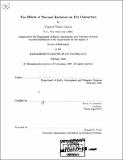| dc.contributor.advisor | Kerry A. Emanuel. | en_US |
| dc.contributor.author | Larson, Vincent Edwin, 1970- | en_US |
| dc.date.accessioned | 2010-04-28T15:31:56Z | |
| dc.date.available | 2010-04-28T15:31:56Z | |
| dc.date.copyright | 1999 | en_US |
| dc.date.issued | 1999 | en_US |
| dc.identifier.uri | http://hdl.handle.net/1721.1/54433 | |
| dc.description | Thesis (Ph.D.)--Massachusetts Institute of Technology, Dept. of Earth, Atmospheric, and Planetary Sciences, 1999. | en_US |
| dc.description | Includes bibliographical references (p. 96-99). | en_US |
| dc.description.abstract | This work seeks to improve understanding of atmospheres in radiative-convective equilibrium. We use two types of idealized, dry radiative-convective models. The first type of model resembles Rayleigh-Benard convection, except that thermal radiative transfer is included. This type of system can be investigated in the laboratory. The second type of model is a more faithful representation of the earth's atmosphere. In this model, the temperature at the upper boundary is left unspecified, unlike the case of Rayleigh-Benard convection. For these two types of radiative-convective models, we perform various theoretical and numerical analyses of the stability properties, and various analyses of the weakly nonlinear convecting state. We prove that in these models, convection arises as monotonically growing cells, not as an oscillatory instability. That is, we prove exchange of stabilities. We investigate the linear stability modes. We find that in most cases, the linear stability threshold can be described approximately or exactly in terms of a radiative Rayleigh number. The radiative Rayleigh numbers used are like the classical Rayleigh number but with modified temperature and thermal diffusivity scales. Inspection of the radiative Rayleigh numbers reveals how various external parameters, such as the net incoming solar radiation or infrared opacity, affect the stability properties. We use the energy method to find a threshold value of a stability parameter below which all disturbances to the radiative equilibrium state, regardless of magnitude, decay. For those radiative equilibrium states which have a linear temperature profile, the energy stability threshold coincides with the linear stability threshold, thereby ruling out the possibility of subcritical instabilities. When the temperature profile is nonlinear, the energy stability profile lies below the linear stability threshold. We study weakly nonlinear convection in the atmospheric radiative-convective model via the mean field approximation. In contrast to the stability threshold, the vertical convective heat flux in the weakly nonlinear convecting state turns out to be little affected by the values of viscosity, thermal diffusivity, or radiative damping. However, the convective heat flux is strongly affected by the net incoming solar radiation and the optical depth. We formulate scaling laws for vertical convective heat flux, vertical velocity, and temperature perturbations. These scales extend the Prandtl scales to higher altitudes. | en_US |
| dc.description.statementofresponsibility | by Vincent Edwin Larson. | en_US |
| dc.format.extent | 99 p. | en_US |
| dc.language.iso | eng | en_US |
| dc.publisher | Massachusetts Institute of Technology | en_US |
| dc.rights | M.I.T. theses are protected by
copyright. They may be viewed from this source for any purpose, but
reproduction or distribution in any format is prohibited without written
permission. See provided URL for inquiries about permission. | en_US |
| dc.rights.uri | http://dspace.mit.edu/handle/1721.1/7582 | en_US |
| dc.subject | Earth, Atmospheric, and Planetary Sciences | en_US |
| dc.title | The effects of thermal radiation on dry convection | en_US |
| dc.type | Thesis | en_US |
| dc.description.degree | Ph.D. | en_US |
| dc.contributor.department | Massachusetts Institute of Technology. Department of Earth, Atmospheric, and Planetary Sciences | |
| dc.identifier.oclc | 42583405 | en_US |
